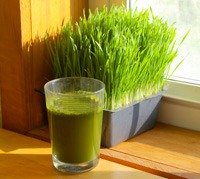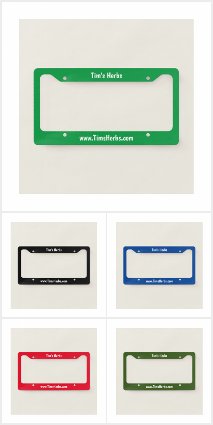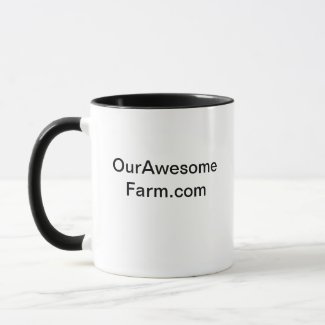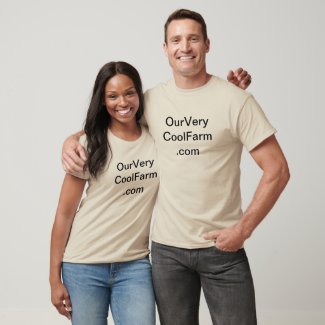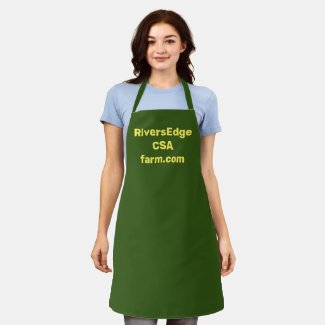Wheatgrass grower carves at-home niche business in the fresh wheatgrass industry
by Barbara Berst Adams A version of this article originally appeared in Urban Farm Magazine
Copyright National Lilac Publishing, LLC
Ellen McGlynn of Clarks Summit, Pennsylvania, is the creator and owner of a successful 2-acre micro eco-farming business called the Wheatgrass Grower, LLC. Wheatgrass as a crop is the first green growth of the wheat plant (hard red winter wheat* -- see more about where to find this seed below) which is juiced for immediate consumption, frozen, or dried into powder for eventual animal and human consumption as a health food. Since the 1930s when it was studied as a possible substance for health, it’s grown in popularity and status as a healing food, reportedly providing quality and good quantities of chlorophyll, amino acids, minerals, vitamins and enzymes.
While Ellen’s main crop is currently wheatgrass, she is also preparing to grow complementary crops on her two acres in addition to the wheatgrass. It appears a small wheatgrass crop alone could be many things to farmers: an addition to a larger farming operation that wants to use a small parcel to diversify, a full time small acreage business, or a consistent part time income. “It is a rewarding small business with a lot of growth potential,” Ellen says, “but it can also work very nicely for someone just looking to make a flexible part-time income, like myself.” Ellen, in fact, had more business than she needed and eventually cut back because she didn’t want or need to work full time. She has arranged her business so she can take summers off to be with her young daughter when school is out, as well as take a little time off during the winter holidays. “In the process of whittling things down,” she says, “I have been able to carve out a small, steady clientele that has enabled me to run a tighter ship and gives me a greater feeling of control.”
From empty basement to thriving business
Ellen lives on and owns three and a half acres. Her property is unique, in that a township line divides the property into two agricultural acres and the remaining one and a half into residential wooded property. Her home and Wheatgrass Grower business occupies the two agriculturally-zoned acres.
The wheatgrass business evolved from her basement. “When I bought my home, it was only three years old,” she says, “and it had an unfinished walk-in basement that I converted into what I would call an herbal workshop. I had a special dedicated HVAC system installed to include electrostatic air cleaning, auto dehumidification, indoor/outdoor air exchange, and ultraviolet air cleaning. The growing area itself is only about a 400 square foot area with a periphery of full-spectrum grow racks (to accommodate up to 120 trays) and two work tables in the center. I also had extra plumbing fixtures installed to accommodate plant watering, cleanup, and various work prep. It’s something that has taken three years to evolve with the help of a patient master plumber. The adjacent basement areas are dedicated to the business for office and creative use.”
Ellen
uses no synthetic pesticides, herbicides, fungicides, or fertilizers.
“I use an all-natural soil growing medium mixed with peat moss and other
organic amendments as necessary,” she says, “such as lime to control
the pH balance or volcanic ash for added minerals.” (Since this writing, Ellen has evolved into a hydroponics method which she describes on her website.)
The business is Certified Naturally Grown, and operates as a limited liability company (LLC). As with many who operate either as a small corporation or LLC, these business entities can protect the business owner’s assets if they are run properly. “It was set up that way as a legal safety net,” Ellen says, and then went on to explain that it also helped make it known she is serious about her business when people see the LLC in her business name.
She has created a very workable and flexible schedule for herself. The business is closed from Memorial Day through Labor Day except for pre-arranged summer events, and also mid-December to mid-January. Otherwise, she is open by appointment Monday – Wednesday, from 10 a.m. to 2 p.m. On days she’s not open to the public, she can fit in other obligations. “I basically had to arrange my hours based on the school system,” she says. “I work minimal off-hours to tend to things like mixing soil, cleaning trays, and tending to various administrative tasks. It’s all very flexible. If there are no appointments on a particular day, I might opt to use that time for something entirely personal, like a doctors’ appointment, and then finish up work at a more convenient time.”
Finding customers and the benefits of keeping them satisfied
Ellen’s small farm business demonstrates how some of the best farm marketing methods are product quality and honest, friendly service that generate serious customer loyalty, even in less than ideal circumstances. Her main customers are individuals who want to consume wheatgrass on a regular basis. Secondary markets are those who use trays of wheatgrass ornamentally, such as florists, spas and wedding parties. “It’s a very slanted percentage, though,” Ellen says. “About 95% of my business caters to customers who consume wheatgrass regularly and are referred to me through health professionals.
“Most of my sales are for cut product. It’s based on a convenience issue for that 95% of my customers who are buying it for juicing purposes and usually do not have the time or patience to deal with a living product. It’s also easier and cleaner to transport and store a small bag rather than a 10” x 20” tray. I don’t often go the route of selling trays for juicing purposes because, according to studies, I believe there is an optimal time to harvest the grass, just as there is an optimal time to pick a tomato. You wouldn’t let a ripe tomato hang on the vine until you were ready to eat it. You would pick it when it was nice and red and either eat it immediately or store it for a short amount of time before it went rotten. Some people are under the impression that harvesting their wheatgrass “fresh” from the tray, no matter when they harvest it, is the best way to go, but the reality is that wheatgrass reaches its peak nutrition on day 10 of growth. After that, nutritional values start to decline. The grass can only extract so much from 1” of soil.
“As for decorative displays, I don’t actually decorate the wheatgrass myself like a florist would (except for personal events), though I do work with customers who are looking for ideas or might have a certain something in mind for their event and the grass base needs to be grown in a special container or flat. Basically, I either grow the grass base they need to work with, or I give them the instructions to help them grow their own. They can then either decorate it themselves or take it to their favorite florist for the finishing touches.”
So, with Ellen’s main customers being clients who want to consume wheatgrass regularly for health reasons, what happens to customers when she closes down for three months? “Obviously, having a summer break is not the most ideal situation for customers who prefer my product,” she says, “but it has to be that way in order for me to be an available parent to my daughter. It's a risk I took last summer not knowing what to expect, and I kind of expected the worst. What happened is that my customers either sought out fresh wheatgrass from other local growers (I even gave them a list of PA and NJ growers because I didn't think it was right for me to just abandon them) or bought frozen wheatgrass juice. In the fall, ALL of my regulars eagerly came back to me because of product quality. It was quite a pleasant surprise, believe me! When and if my client base drops below a comfortable business-operating level, I will again approach the medical offices who use me as a referral in order to increase my customer base, but that has not happened yet.
Product expansion and agritourism possibilities
Beyond wheatgrass, Ellen is exploring ways to add additional crops that fit the needs of her current clientele and still allows for summers off so she can spend full time with her young daughter. She describes these new crops as, “Medicinal and culinary herbs and small fruits—‘functional foods’—plants and foods that have such exceptional nutritional value that consumers include them in their diet for specific health reasons, such as garlic for the reduction or prevention of arterial plaque buildup.”
As Ellen works on her additional outdoor crop ideas, the wheatgrass operation is getting closer to coming full circle in its operation. “Outside,” she explains, “I had a large cedar-fenced garden area installed, which is where I currently take the wheatgrass mats (what remains after the wheatgrass is cut) for composting. Half of the garden is used for planting, half for composting. The intent is to recycle the composted matter for future wheatgrass crops, though currently it is only being used to build up the soil in this large fenced garden area. The wheatgrass mats compost down to perfection.”
Ellen admits that only about half of the two acres she farms and lives on are actually dedicated to the garden and mini-farm operation. And about ¾ of that land is a steep hillside where high winds and other natural challenges have made indoor farming her favorite segment of farming so far. “After consultation with professionals at Cornell’s Cooperative Extension, it seems the only method of weed eradication is years of constant cutting until the weeds get worn out,” she says. “Being a steep hillside, I’m the one who’s getting worn out.”
As mentioned, Ellen once operated the wheatgrass business full time, but cut back to have more time available for her daughter’s school schedule. But that school just may prove to be a direction for expanding her business. “I have also been using the time to explore new, less physically demanding aspects of the business such as herbal workshops,” she says. “I am currently putting together a children’s Christmas herbal workshop for my daughter’s first-grade class in early December. I am fortunate that my daughter’s school allows me to both educate and entertain the kids this way. It’s a great way for me to volunteer with the school and participate in my child’s education while honing and exploring other potential business avenues for my craft.”
There have been challenges for Ellen. She stated that pest problems may be appearing on some of her new outdoor garden projects, and she works closely with local experts on maintaining eco-friendly standards, avoiding the fast-but-toxic way out. But she seems to be on a successful small farming journey that’s taking her just where she needs to go.
“There have been many happy, satisfying moments about this business,” Ellen says. “I have worn many hats in my lifetime--held many jobs and have done them well--but in today's fast-paced world, often people don't stop to say 'thanks.' In this business, the gratefulness and the thanks are heard loud and clear and often.
"Fresh wheatgrass is a hard-to-find product and finding it doesn't always guarantee its quality, so people are quite appreciative with what I'm doing. Keeping the business small and personal, I think, is how I'm able to maintain product quality. Whenever people tell me how well they or a loved one are feeling or how beautiful their greens arrived in shipment, that's always a happy moment for me. It's the 'thanks' that really fuel this business.”
Update: Since this writing, Ellen has added raw artisanal honey and honeybee supplies to her microfarming business.
*Editor's note: For those asking, "Where can I buy wheatgrass seed?" -- there are several sources depending on if you're experimenting with a little at first or want a large quantity in bulk. The type of wheat seeds (usually called wheat "berries" instead of wheat seeds) you need are hard red winter wheat. Large quantities can be found in some farm and feed stores, some of which offer organic. You may find large bins full of oats, buckwheat, etc. in these stores where you scoop the desired amount into provided paper sacks to be weighed and paid for. Just be sure you get the right kind of wheat for wheatgrass, because these stores sell other types of seed for wheat such as soft red, hard white, and soft white. Also in these stores, you may find prepackaged bags of organic wheatgrass seed in the poultry section for farmers who buy it to sprout to feed their chickens. For smaller amounts, some health food stores and food co-ops have a sprouting section where they sell various types of sprouting seeds such as alfalfa and mung beans, possibly including the hard red winter wheat for wheatgrass. And finally, there are online stores that specialize in selling wheatgrass seeds (berries) to wheatgrass growers. Since it's popular to add various chemicals to crop seeds, be sure you find organic wheat seed that's organic or at least quranteed free of all chemicals.
______________
See also our articles on how farmers find ways to fully protect and insure their farm businesses with sometimes very low (or even free) yearly insurance costs:


